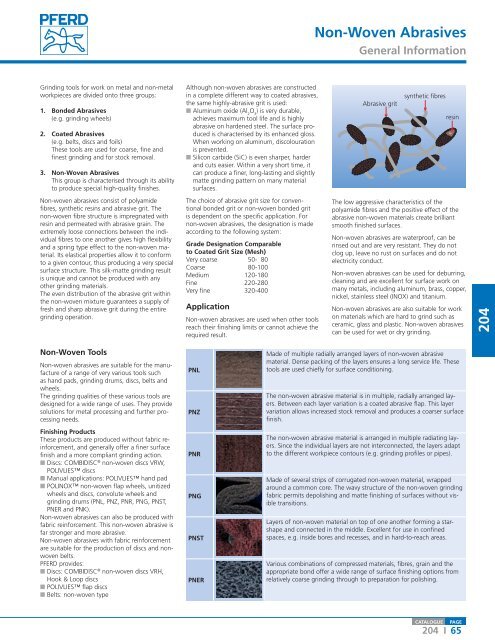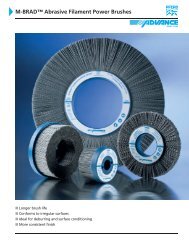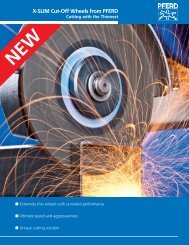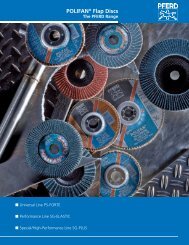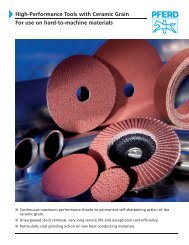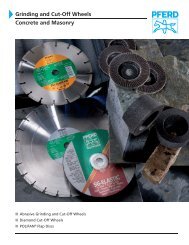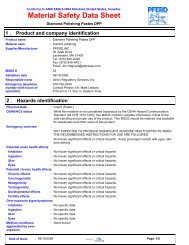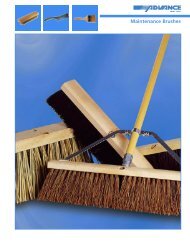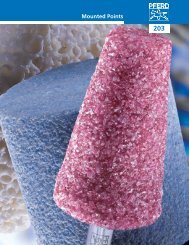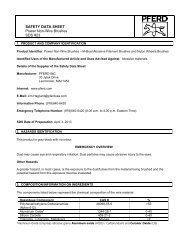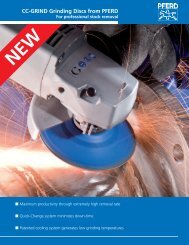Coated and Non-Woven Abrasives - Pferd
Coated and Non-Woven Abrasives - Pferd
Coated and Non-Woven Abrasives - Pferd
Create successful ePaper yourself
Turn your PDF publications into a flip-book with our unique Google optimized e-Paper software.
<strong>Non</strong>-<strong>Woven</strong> <strong>Abrasives</strong><br />
General Information<br />
Grinding tools for work on metal <strong>and</strong> non-metal<br />
workpieces are divided onto three groups:<br />
1.<br />
Bonded <strong>Abrasives</strong><br />
(e.g. grinding wheels)<br />
2. <strong>Coated</strong> <strong>Abrasives</strong><br />
(e.g. belts, discs <strong>and</strong> foils)<br />
These tools are used for coarse, fine <strong>and</strong><br />
finest grinding <strong>and</strong> for stock removal.<br />
3. <strong>Non</strong>-<strong>Woven</strong> <strong>Abrasives</strong><br />
This group is characterised through its ability<br />
to produce special high-quality finishes.<br />
<strong>Non</strong>-woven abrasives consist of polyamide<br />
fibres, synthetic resins <strong>and</strong> abrasive grit. The<br />
non-woven fibre structure is impregnated with<br />
resin <strong>and</strong> permeated with abrasive grain. The<br />
extremely loose connections between the individual<br />
fibres to one another gives high flexibility<br />
<strong>and</strong> a spring type effect to the non-woven material.<br />
Its elastical properties allow it to conform<br />
to a given contour, thus producing a very special<br />
surface structure. This silk-matte grinding result<br />
is unique <strong>and</strong> cannot be produced with any<br />
other grinding materials.<br />
The even distribution of the abrasive grit within<br />
the non-woven mixture guarantees a supply of<br />
fresh <strong>and</strong> sharp abrasive grit during the entire<br />
grinding operation.<br />
Although non-woven abrasives are constructed<br />
in a complete different way to coated abrasives,<br />
the same highly-abrasive grit is used:<br />
■■Aluminum oxide (Al O ) is very durable,<br />
2 3<br />
achieves maximum tool life <strong>and</strong> is highly<br />
abrasive on hardened steel. The surface produced<br />
is characterised by its enhanced gloss.<br />
When working on aluminum, discolouration<br />
is prevented.<br />
■■Silicon carbide (SiC) is even sharper, harder<br />
<strong>and</strong> cuts easier. Within a very short time, it<br />
can produce a finer, long-lasting <strong>and</strong> slightly<br />
matte grinding pattern on many material<br />
surfaces.<br />
The choice of abrasive grit size for conventional<br />
bonded grit or non-woven bonded grit<br />
is dependent on the specific application. For<br />
non-woven abrasives, the designation is made<br />
according to the following system:<br />
Grade Designation Comparable<br />
to <strong>Coated</strong> Grit Size (Mesh)<br />
Very coarse 50- 80<br />
Coarse 80-100<br />
Medium 120-180<br />
Fine 220-280<br />
Very fine 320-400<br />
Application<br />
<strong>Non</strong>-woven abrasives are used when other tools<br />
reach their finishing limits or cannot achieve the<br />
required result.<br />
Abrasive grit<br />
synthetic fibres<br />
resin<br />
The low aggressive characteristics of the<br />
polyamide fibres <strong>and</strong> the positive effect of the<br />
abrasive non-woven materials create brilliant<br />
smooth finished surfaces.<br />
<strong>Non</strong>-woven abrasives are waterproof, can be<br />
rinsed out <strong>and</strong> are very resistant. They do not<br />
clog up, leave no rust on surfaces <strong>and</strong> do not<br />
electricity conduct.<br />
<strong>Non</strong>-woven abrasives can be used for deburring,<br />
cleaning <strong>and</strong> are excellent for surface work on<br />
many metals, including aluminum, brass, copper,<br />
nickel, stainless steel (INOX) <strong>and</strong> titanium.<br />
<strong>Non</strong>-woven abrasives are also suitable for work<br />
on materials which are hard to grind such as<br />
ceramic, glass <strong>and</strong> plastic. <strong>Non</strong>-woven abrasives<br />
can be used for wet or dry grinding.<br />
204<br />
<strong>Non</strong>-<strong>Woven</strong> Tools<br />
<strong>Non</strong>-woven abrasives are suitable for the manufacture<br />
of a range of very various tools such<br />
as h<strong>and</strong> pads, grinding drums, discs, belts <strong>and</strong><br />
wheels.<br />
The grinding qualities of these various tools are<br />
designed for a wide range of uses. They provide<br />
solutions for metal processing <strong>and</strong> further processing<br />
needs.<br />
Finishing Products<br />
These products are produced without fabric reinforcement,<br />
<strong>and</strong> generally offer a finer surface<br />
finish <strong>and</strong> a more compliant grinding action.<br />
®<br />
■ ■Discs: COMBIDISC non-woven discs VRW,<br />
POLIVLIES discs<br />
■■Manual applications: POLIVLIES h<strong>and</strong> pad<br />
■■POLINOX non-woven flap wheels, unitized<br />
wheels <strong>and</strong> discs, convolute wheels <strong>and</strong><br />
grinding drums (PNL, PNZ, PNR, PNG, PNST,<br />
PNER <strong>and</strong> PNK).<br />
<strong>Non</strong>-woven abrasives can also be produced with<br />
fabric reinforcement. This non-woven abrasive is<br />
far stronger <strong>and</strong> more abrasive.<br />
<strong>Non</strong>-woven abrasives with fabric reinforcement<br />
are suitable for the production of discs <strong>and</strong> nonwoven<br />
belts.<br />
PFERD provides:<br />
®<br />
■ ■Discs: COMBIDISC non-woven discs VRH,<br />
Hook & Loop discs<br />
■■POLIVLIES flap discs<br />
■■Belts: non-woven type<br />
PNL<br />
PNZ<br />
PNR<br />
PNG<br />
PNST<br />
PNER<br />
Made of multiple radially arranged layers of non-woven abrasive<br />
material. Dense packing of the layers ensures a long service life. These<br />
tools are used chiefly for surface conditioning.<br />
The non-woven abrasive material is in multiple, radially arranged layers.<br />
Between each layer variation is a coated abrasive flap. This layer<br />
variation allows increased stock removal <strong>and</strong> produces a coarser surface<br />
finish.<br />
The non-woven abrasive material is arranged in multiple radiating layers.<br />
Since the individual layers are not interconnected, the layers adapt<br />
to the different workpiece contours (e.g. grinding profiles or pipes).<br />
Made of several strips of corrugated non-woven material, wrapped<br />
around a common core. The wavy structure of the non-woven grinding<br />
fabric permits depolishing <strong>and</strong> matte finishing of surfaces without visible<br />
transitions.<br />
Layers of non-woven material on top of one another forming a starshape<br />
<strong>and</strong> connected in the middle. Excellent for use in confined<br />
spaces, e.g. inside bores <strong>and</strong> recesses, <strong>and</strong> in hard-to-reach areas.<br />
Various combinations of compressed materials, fibres, grain <strong>and</strong> the<br />
appropriate bond offer a wide range of surface finishing options from<br />
relatively coarse grinding through to preparation for polishing.<br />
CATALOGUE<br />
204 I<br />
PAGE<br />
65


